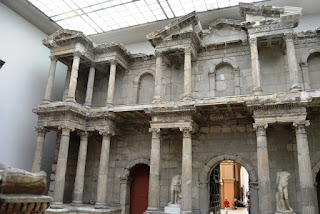(Please read our Covid 19 Statement first - Ed) We're on the Cold War and Nazi trail here in Berlin. Earlier today, we visited the seat of the country's government at the Reichstag, visited for formerly forbidden Brandenberg Gate, and remembered the innocents slaughtered at the Holocaust Memorial.
Watch the Video!
A few blocks away from Checkpoint Charlie's tourist horde, we find a more manageable leftover piece of the Berlin Wall. About 200 yards of the barrier have been preserved as an open-air museum called the Topography of Terror.
An accessible path takes you along this section of wall, separating what was the bombed out ruins of the Third Reich's administrative buildings and the apartment buildings across the street in what used to be East Berlin. There is a chunk missing, where the first section of the hated wall was broken through giving access to the west for the Berliners of the east.
Many more holes are punched through the wall, exposing the rebar in the concrete, giving evidence of the citizens of the city rushing to tear down the wall with hammers, picks, and crowbars.
Ramps lead to a section below with many photos exhibits of the Nazi era events and locations that took place in this mostly vacant field.
The history here is enveloping and, since it's completely free, devoid of the tourist trap atmosphere that pervades the Checkpoint Charlie area on Friedrichstrasse.
It's time to break for lunch so we find a very nice Italian place, Ristorante Marinelli, across from the Anhalter Station.
There is still a façade standing at this old train station, the only thing left standing after World War II bombing raids. The only trains now are the S-Bahn trains running in the station underground.
During the war, Jews were rounded up and brought here to board trains to their awful fates in the concentration camps. This façade, and a few interpretive displays, were left as a memorial.
Below, we board a train heading for the eastern side of the city where we'll visit Museum Island to end our day.
It's a short walk from the Hackescher Markt station then a walk on a bridge across the River Spree, hard by the Berliner Dom cathedral, to reach Museum Island. Here, five state museums form a UNESCO Heritage Site where visitors can see some of the great treasures of this city.
Some parts still show war damage from seventy years ago.
Our destination is the Pergamon Museum, which features very large, reconstructed buildings from the ancient age. It's star attraction, the Pergamon Altar, is closed for renovation for a couple of years but we are able to see it's other great restorations.
The deep blue tiles of the Ishtar Gate, recovered from Iraq and brought to Berlin to be rebuilt, brick-by-brick, used to guard an entrance to Babylon. Three thousand years have not dulled the brilliant colors.
This was a "small" gate into the old city but we are dwarfed by its massive dimensions.
Dragons, lions, and other beasts are depicted on it's walls. The hall leading up to it is a reconstructed street that led up to the gate.
A model shows just how puny this reconstructed section is when compared to the entire gate complex.
Behind the gate, a Roman temple has also been brought to Germany and rebuilt in this massive hall.
Columns, mosaic floors, and busts of leaders who thought themselves gods adorn the walls.
I'm a bit blown away by the large temple but even more so when I turn around and notice the other half is behind me.
Our long day of Berlin touring, hitting all the major stops on our Cold War and World War II lists, has come to and end. We make our way back to the S-Bahn and on to Potsdamerstrasse to have another delicious Turkish dinner at Café Neffes near our hotel.
We'll rest up, drinking some great German Riesling while watching corny German language gameshows and continue on tomorrow.
Darryl
Copyright 2016 - Darryl Musick
All Rights Reserved
Photos by Letty Musick
Copyright 2016 - All Rights Reserved












No comments:
Post a Comment